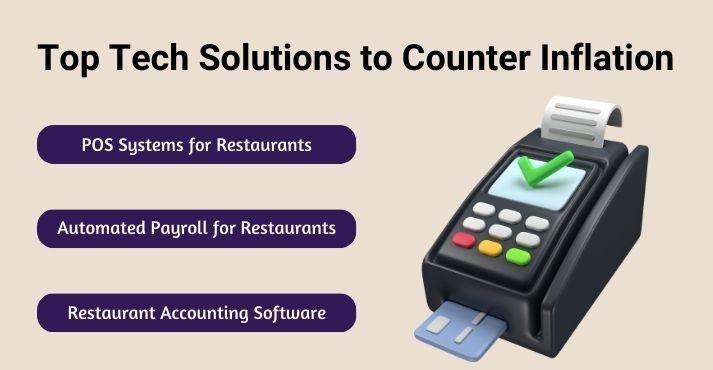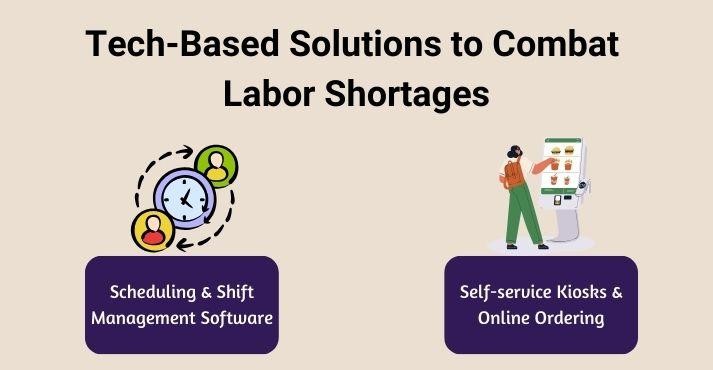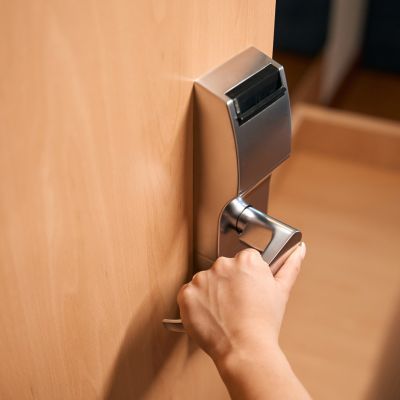Economic challenges have hit The restaurant industry hard, with inflation and labor shortages at the forefront.
According to a report by the National Restaurant Association, 98% of restaurants experienced significant operational cost increases in 2024 due to inflation.
Rising food prices, supply chain disruptions, and labor shortages force restaurants to rethink their operations to survive in this challenging climate.
Restaurants face increasing costs for food, utilities, and wages while struggling to find and retain reliable staff.
These issues are driving up operational costs and threatening the long-term sustainability of many businesses.
To overcome these challenges, F&B business owners use restaurant technologies to combat inflation and labor shortages.
Solutions that can improve efficiency, cut costs, and fill gaps caused by the restaurant labor shortage are in demand. From automation to restaurant POS systems, technology is a vital tool in keeping restaurants afloat.
“In a survey that we ran, we found that 3/4th of our respondents plan to increase their technology spending in 2023, with leading solutions being POS, payroll, and accounting software.”
Amy Lecza, Director of Content Marketing & SEO at Toast
This shift toward more significant investment in technology shows businesses are ready to adopt modern solutions to tackle long-standing problems.
Impact of Inflation and Labor Shortages on Restaurants
The combined impact of inflation and labor shortages reshapes the hospitality industry, putting unprecedented pressure on business owners to adapt quickly.
Inflation’s Effects on Food Costs and Operations
Inflation has had a particularly severe impact on food costs. With the price of raw ingredients skyrocketing, restaurants and hotel operations are impacted, as they are paying more than ever to maintain their inventory.
For example, the price of common ingredients like meat, dairy, and produce has surged, creating significant food inflation and financial stress.
Additionally, operational costs such as rent, utilities, and maintenance have risen sharply, making it harder for restaurants to maintain profitability. The result is reduced sales and lower profit margins, and the need to cut costs wherever possible.
Restaurants are also feeling the pinch when it comes to supply chain disruptions. Delays in receiving products, shortages of essential ingredients, and higher shipping costs are common issues in the current economic climate.
These challenges push restaurants to explore technology solutions that streamline operations and reduce waste.
The Labor Shortage Crisis
The restaurant labor shortage has been equally devastating. Even as the demand for dining experiences returns to pre-pandemic levels, many restaurants struggle to find enough staff to meet that demand.
Hiring qualified employees has become a significant hurdle, and turnover rates remain high. The labor shortage is not only causing operational inefficiencies but is also negatively impacting the customer experience.
Restaurants are finding themselves operating with fewer employees, leading to:
- Longer wait times
- Decreased service quality
- Increased stress on existing staff
In such a strained environment, many restaurant owners are forced to offer higher wages to attract workers, further driving up operational costs. However, even with increased wages, restaurants still struggle to retain talent.
These economic pressures drive the need for innovative solutions to help businesses remain competitive in a challenging market.
Hospitality technology is crucial in addressing inflation and labor shortages, allowing restaurants to do more with less.
Top Tech Solutions to Combat Inflation

As restaurant owners look for ways to stay afloat in this harsh economic climate, they turn to technology to reduce costs, increase efficiency, and modernize operations. Here are some of the most influential restaurant technologies to combat inflation and labor shortage:
1. POS Systems for Restaurants
One of the most essential tools for modern restaurants is a POS system.
These systems have evolved from simple cash registers into sophisticated platforms that handle various operational tasks, from managing sales and inventory to providing data insights that help reduce food wastage and improve profit margins.
With inflation driving up the cost of food, it’s more important than ever for restaurants to monitor their inventory closely.
Modern restaurant POS systems, like Toast POS, offer real-time data on inventory levels, helping restaurant owners avoid over-ordering and reducing food waste.
By tracking sales trends, these systems can also help restaurants forecast demand more accurately, allowing them to adjust their menu offerings and pricing strategies to maximize profits.
POS systems also rationalize the customer experience by providing faster and more efficient transaction processing.
Contactless payment options, which have become increasingly popular during the COVID-19 pandemic, reduce the need for physical interaction and speed up the checkout process, making it more convenient for customers and staff.
POS system in a restaurant like Toast POS is a leader in this space, offering advanced features like:
- Mobile payment integration
- Online ordering
- Customer loyalty programs
These features help restaurants retain customers, increase revenue, and combat rising costs. By investing in restaurant POS systems, businesses can improve their efficiency and profitability in an inflationary environment.
2. Automated Payroll for Restaurants
Managing payroll manually can be time-consuming and prone to errors, especially in a fast-paced restaurant environment. Automated restaurant payroll is becoming a must-have technology for restructuring employee management and reducing administrative costs.
Payroll automation software, such as Gusto and Toast Payroll, simplifies the process of paying employees and ensures that they are compensated accurately and on time.
With rising wages due to the labor shortage, payroll accuracy is critical for controlling costs. By automating payroll, restaurants can avoid costly errors that result from manual calculations, such as overpayments or underpayments.
This technology also helps restaurants comply with labor laws and tax regulations, reducing the risk of penalties.
Benefits of automated payroll for restaurants include:
- Integration with scheduling and time-tracking software
- Accurate payment processing
- Reduction in manual payroll errors
- Compliance with labor regulations
This integration ensures that employee hours are accurately recorded, and managers can easily adjust shifts to optimize labor costs.
In a climate where controlling expenses is paramount, hospitality management tools like automated payroll solutions offer significant cost-saving potential.
3. Restaurant Accounting Software
Effective financial management has never been more critical as inflation drives up business costs.
Restaurant accounting software like QuickBooks and Xero is helping restaurant owners monitor their finances, enabling them to make data-driven decisions that improve budgeting and forecasting.
Accounting software offers several key features that help restaurants manage their financial health. First, it provides real-time insights into revenue, expenses, and profit margins, allowing owners to identify areas where costs can be reduced.
For example, by analyzing expense reports, restaurant owners can identify suppliers offering better pricing or determine which menu items are the most profitable.
Additionally, restaurant accounting software automates many of the financial tasks that would otherwise require a dedicated accounting team, such as:
- Invoicing
- Expense tracking
- Tax Preparation
This automation reduces the need for manual data entry, which can be time-consuming and error-prone.
Technology Solutions to Address Labor Shortages

In addition to addressing inflation, technology is playing a critical role in mitigating the impact of the restaurant labor shortage. Here are some of the most effective solutions:
1. Scheduling & Shift Management Software
One of restaurant owners’ biggest challenges in the current labor market is effectively managing staff schedules. Scheduling and shift management software like 7shifts and Deputy helps restaurants optimize labor costs by automating the process of creating work schedules and tracking employee availability.
These tools allow managers to set up flexible schedules that match the needs of both the business and the employees.
For example, managers at Marriot created shift rotations for housekeeping staff that prevented overstaffing during slow periods or understaffing during busy hours. This reduces labor costs and improves employee satisfaction by offering more control over their working hours.
Benefits of scheduling and shift management software include:
- Real-time employee attendance tracking
- Labor law compliance
- Easy shift adjustments in case of no-shows or staffing changes
By optimizing staffing levels and reducing labor costs, scheduling and shift management software is valuable for restaurants looking to combat the challenges of a tight labor market.
2. Self-service Kiosks & Online Ordering
Due to the labor shortage, restaurants have fewer front-of-house staff, so they increasingly turn to self-service kiosks and online ordering platforms to maintain service levels without overburdening employees.
Self-service kiosks allow customers to place their orders directly, reducing the need for staff to take orders manually. This technology improves efficiency and reduces wait times, enhancing the overall customer experience.
In fast-casual and quick-service restaurants, self-service kiosks are becoming common in establishments looking to rationalize operations.
Similarly, online food delivery technology has become a lifeline for restaurants during the labor shortage.
Platforms like GrubHub, UberEats, and DoorDash allow customers to order food for delivery or pickup, enabling restaurants to reach a broader audience without requiring additional staff.
These technologies reduce labor costs and increase revenue by making it easier for customers to order food. Investing in self-service kiosks and online ordering platforms is a smart move for restaurants needing help to keep up with demand due to staffing shortages.
Future Trends in Restaurant Tech Adoption

As restaurant owners continue to face challenges related to inflation and labor shortages, the adoption of restaurant technology is expected to accelerate.
1. Expansion of Automation
Restaurant automation is expected to grow in the coming years. Technologies like AI-powered kitchen systems, robotic chefs, and automated food preparation machines are already used in restaurants.
These innovations promise to reduce labor costs by automating repetitive tasks like cooking, food preparation, and even cleaning.
As the labor shortage persists, more restaurants will turn to automation to fill the gaps in their workforce. This technology addresses labor shortages and improves consistency and efficiency in food production, reducing the margin for human error.
2. Investment in Green Tech
Another emerging trend is the integration of sustainable technologies to combat rising operational costs.
With rising energy prices, many restaurants invest in energy-efficient appliances, solar panels, and other green technologies to reduce their utility bills. These investments not only cut costs but also appeal to environmentally conscious customers.
As more consumers prioritize sustainability in their purchasing decisions, restaurants that adopt green technologies may gain a competitive edge in the market.
Conclusion
Restaurant technologies to combat inflation and labor shortage are becoming indispensable for business survival in today’s challenging economic climate.
From restaurant POS systems to automated payroll for restaurants and restaurant accounting software, these solutions offer restaurant owners the tools to reduce costs, optimize operations, and improve the customer experience.
As inflation and labor shortages continue to affect the industry, investing in the right technologies will be key to staying competitive and profitable.











